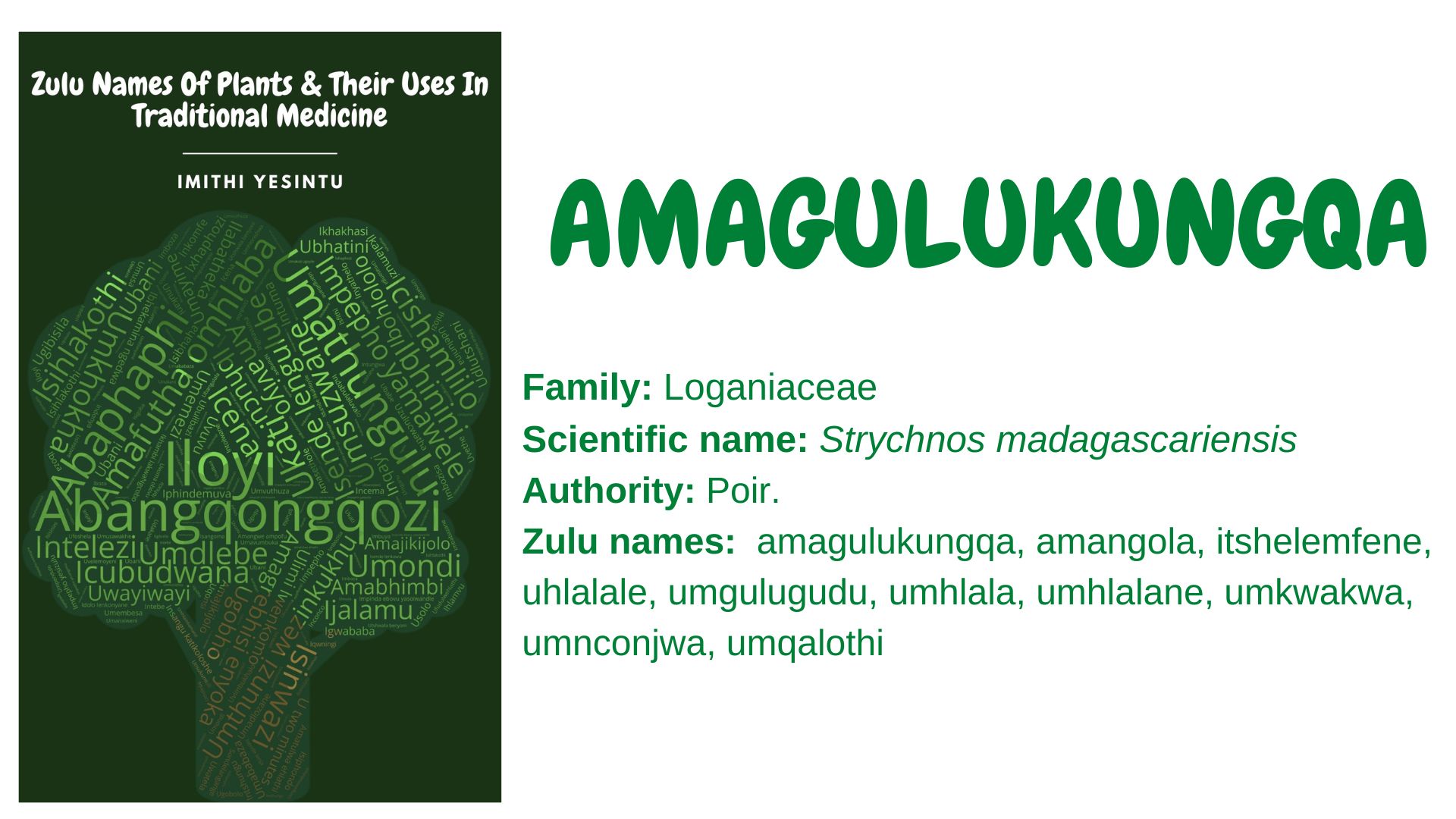Family: Loganiaceae
Scientific name: Strychnos madagascariensis
Authority: Poir.
Synonyms: Strychnos behrensiana Gilg & Busse, Strychnos burtonii Baker, Strychnos dysophylla Benth., Strychnos engleri Gilg, Strychnos leiocarpa Gilg & Busse, Strychnos melonicarpa Gilg & Busse, Strychnos pachyphylla Gilg & Busse, Strychnos polyphylla Gilg & Busse, Strychnos quaqua Gilg, Strychnos randiaeformis Baill., Strychnos stenoneura Gilg & Busse, Strychnos wakefieldii Baker
Zulu names: amagulukungqa, amangola, itshelemfene, umgulugudu, umhlala, umhlalane, umhlalale, umkwakwa, umnconjwa, umqalothi, ungquluzemfene
Other names: black monkey orange, spineless monkey orange, wild orange (English) botterklapper, swartklapper (Afrikaans)
Plant description: S.madagascariensis is a small tree that grows up to 8 m in height. It has green leaves clustered at the end of the twigs, yellowish flowers clustered at the base of the leaves, smooth pale grey bark, and large edible fruits that turn yellow when ripe. S. madagascariensis is endemic to South Africa, Lesotho, Zimbabwe, and Swaziland. It can be found growing in woodlands, coastal forests, rocky terrains, and the banks of streams.
Uses:
- The edible fruits are eaten as food. They can also be eaten as an appetiser, to stimulate appetite.
- The pulp from the fruit is often mixed with mealie meal and the mixture used to make porridge.
- The seeds are pounded to make an edible powder that is then used to make a traditional drink known as amahewu that is used to treat diarrhoea. The bark, leaves, and roots are also used to treat diarrhoea.
- The plant is used to treat reproductive disorders in men such as impotence and lack of virility.
- The fruits are used to treat inflammation. The powder from the charred fruit is rubbed into the incisions to treat swollen testicles.
- The fruits are used to treat Tungiasis, a skin infection caused by Tunga penetrans.
- The leaves are used to treat reproductive issues in women such as excessive and irregular menstruations.
- The leaves are used to make poultice for treating burns, sores, and ringworms.
- The bark is ground to powder and taken to treat nausea.
- The bark is taken as a purgative, very strong laxative.
- The bark is used to treat colic.
- The roots are mixed with those of Turraea floribunda to treat pain caused by rheumatism.
- The fruits are used to make an infusion that is taken as tea to treat hypertension (high blood pressure).
- The plant is used as anthelmintic, to expel parasitic intestinal worms.
- The plant is used to treat sore eyes.
- The plant is taken to manage diabetes.
- The plant is taken as an emetic, to induce emesis.
Safety precaution:
Using traditional medicine responsibly can enhance your overall health and well-being. Misuse and abuse can lead to complications. You can inquire about the correct use of traditional medicine from a knowledgeable herbalist and practitioner. You can also visit imithiyesintu.co.za or email: info@imithiyesintu.co.za to learn more about traditional medicine
References and further reading:
- Chemane, S.S.I., 2022. Nutritional Characterization of the fruit Strychnos madagascariensis and their products: flour and oil.
- Corrigan, B.M., Van Wyk, B.E., Geldenhuys, C.J., and Jardine, J.M., 2011. Ethnobotanical plant uses in the KwaNibela Peninsula, St Lucia, South Africa. South African Journal of Botany 77, pp. 346–359.
- De Wet, H., Nkwanyana, M.N., and Van Vuuren, S.F., 2010. Medicinal plants used for the treatment of diarrhoea in northern Maputaland, KwaZulu-Natal Province, South Africa. Journal of Ethnopharmacology 130, pp. 284–289.
- De Wet, H., Ramulondi, M., and Ngcobo, Z.N., 2016. The use of indigenous medicine for the treatment of hypertension by a rural community in northern Maputaland, South Africa. South African Journal of Botany 103, pp. 78–88.
- Maroyi, A., 2011. An ethnobotanical survey of medicinal plants used by the people in Nhema communal area, Zimbabwe. Journal of Ethnopharmacology 136, pp. 347–354.
- Watt, J.M., and Breyer-Brandwijk, M.G., 1962. Medicinal and poisonous plants of southern and eastern Africa, second edition. Livingstone, London.
You Can Order Your Copy Of The Book By Emailing: info@imithiyesintu.co.za
Feel Free To Add Other Uses Of This Plant In The Comment Section Below:

